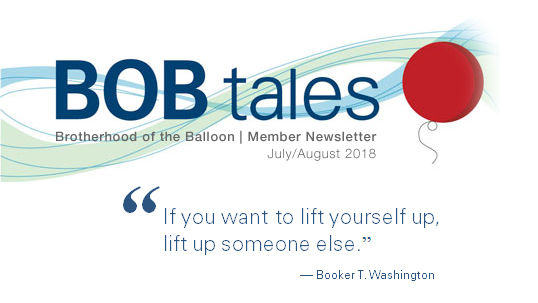
Dear Members: (a note from Deb Hickey):
I made a friend last month—not in a conventional way, though. Kate found me on cancer support group website, Cancer Compass. In 2014, that was a place I poured out my heart and soul for anyone in the world who would listen; for someone to give me hope; for just one person to come forward and tell me he/she had survived the same horrific illness my husband was just diagnosed with. In the end, I ended up being that person for Kate.
If you’ve been a member for more than four years, you’ve probably heard my story in the BOB Tales. My husband, Mark, was diagnosed with advanced, metastatic pancreatic cancer in March 2014. He was given months to live. The news hit me like a semi truck and all the muscles in my body gave out. Thinking back to that time fills my heart with dread. I wouldn’t wish that fear and hopelessness on anyone.
Kate is 32 years old. She just gave birth to her second child. Doctors thought the pain in her abdomen was pregnancy-related. It wasn’t. Kate was diagnosed with pancreatic cancer during her third trimester. In April, she was given less than a year to live.
I received a message the first week of June through Cancer Compass with the subject line, “Help me!” By mid-month, I had met Kate (who lives in Boston) and her family three times—the first time I delivered a prayer blanket; the second time I gave them blessed rosary beads; and the third time I prayed with them. Kate’s parents introduced me to other family members as “Kate’s Angel.”
Mark’s remission is not without loss—he closed his business and took a salary job that pays a fraction of what he used to make; he suffers from severe neuropathy in his feet and hands, as well as a loud ringing in his ears along with significant hearing loss, all from chemotherapy; and the fear of a recurrence is very real. But, he’s gained immense appreciation for life, his family, and things as small as a hot cup of coffee—and so have I. We’ve had four years beyond what we thought we’d have when we were told by one doctor, “There is no cure. You will lose him by the end of the summer.”
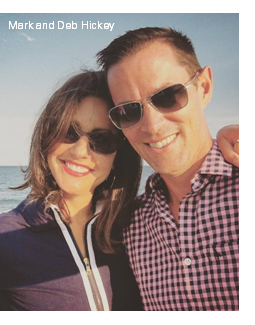 I don’t know if Kate will beat this, but I feel compelled to help her—almost like, without trying to sound schmaltzy, I was meant to. Perhaps the gift we’ve been given and these four “extra” years with Mark have put me in the exact place I need to be for Kate and her family.
I don’t know if Kate will beat this, but I feel compelled to help her—almost like, without trying to sound schmaltzy, I was meant to. Perhaps the gift we’ve been given and these four “extra” years with Mark have put me in the exact place I need to be for Kate and her family.
Fourteen years before Mark’s diagnosis, my father revealed he had prostate cancer. I was 27 years old and it was two months before my wedding. I didn’t think he’d be able to walk me down the aisle and he most certainly would never meet his grandchildren. Wrong and wrong.
Loma Linda and proton therapy saved my father and preserved the quality of his life. I can’t say nothing changed after his treatment, because everything changed. He had more lust for life and he decided to dedicate himself to helping others survive and thrive after prostate cancer.
My father is another reason I feel compelled to pay it forward every day in the correspondence I have with men who have just been given a prostate cancer diagnosis. Sure, it’s “my job,” but I’ve been there—with my father and with my husband. I know the fear well. Because of that, I feel uniquely connected to these men and an innate urge to help them.
Just yesterday, a gentleman wrote, “I am a nervous wreck. I can’t sleep, eat, or concentrate on anything.” When messages like these come in, I drop everything and take the time to respond as thoughtfully and sensitively as I can. In this specific case, after a few back-and-forth emails, he wrote, “I want to thank you from the bottom of my heart for letting me ‘cry on your shoulder.’” That’s what I’m here for. I really believe that’s what I’m here for.
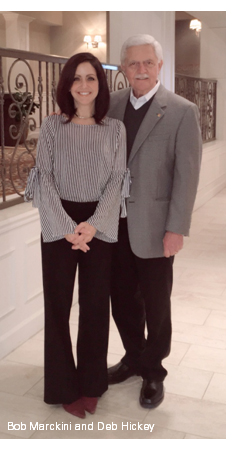 Most of you have experienced a miracle—you found your way to a treatment for prostate cancer that spared you the debilitating side effects resulting from other treatment options. Some of you spent weeks, even months, researching treatment modalities; some spent hours hunting down and speaking with former patients; some read book after book, article after article, study after study; some of you fought your insurance companies for coverage—some of you won; some of you didn’t. Most of you are alive and well today because of the gift of proton therapy.
Most of you have experienced a miracle—you found your way to a treatment for prostate cancer that spared you the debilitating side effects resulting from other treatment options. Some of you spent weeks, even months, researching treatment modalities; some spent hours hunting down and speaking with former patients; some read book after book, article after article, study after study; some of you fought your insurance companies for coverage—some of you won; some of you didn’t. Most of you are alive and well today because of the gift of proton therapy.
If you’re like me, you feel compelled to pay it forward; you feel like you have something to give to others—hope, reassurance, comfort—and in doing so, you’re given an even greater gift (“If you want to lift yourself up, lift up someone else.”).
If you have a story of how you’ve “paid it forward,” please share it with me.
This is our summer double issue of BOB Tales and we cover many topics including a new blood test that could reduce the necessity of biopsies for prostate cancer by almost half; the importance of MRIs for reducing unnecessary biopsies; why quitting smoking after a prostate cancer diagnosis is even more important than you may have thought; and ways to help prevent prostate cancer even if you have a genetic predisposition for the disease. We also include a couple of short stories about members treated more than 10 years ago—one who was treated 27 years ago!
We hope you are all enjoying a relaxing summer with friends and family. And as always, we hope you enjoy this issue of BOB Tales and we welcome your feedback.
Deb Hickey
To print the BOB Tales newsletter or view the newsletter with a larger font size, click here for the PDF file.
In this Issue:
- New Blood Test May be Superior to PSA for Detecting High Grade Prostate Cancer
- MRI May Reduce Unnecessary Biopsies
- Diagnosed with Prostate Cancer? Stop Smoking.
- Eating Your Way to Better Prostate Health
- Preventing and Surviving Prostate Cancer
- The Top 20 Most Healthful Foods
- Surprising Health Risk for Men

New Blood Test May be Superior to PSA for Detecting High-Grade Prostate Cancer
The IsoPSA assay could reduce the necessity of biopsies for prostate cancer by almos t half resulting in less overtreatment of the disease, according to researchers. A report on this test was presented at the Annual Meeting of the American Urological Association.
Lower-grade cancers could possibly be followed by active surveillance, thus saving the patient a needless biopsy as well as invasive treatment with attendant side effects.
Click here for more information.
MRI May Reduce Unnecessary Prostate Biopsies
We’ve written about this before and it’s so important, it bears repeating. Another article on this subject was published by Harvard Medical School’s Harvard Men’s Health Watch last month.
You might think this shouldn’t be of much interest to those of us who have already been treated for prostate cancer, but it should be of interest for a couple of reasons: First, we all have friends and family members who will someday develop prostate cancer. If they proceed along the conventional route, they will likely have 35-year-old blind biopsy technology.
This means the cancer can be missed; or if found, it’s possible and common for more aggressive cancer to be missed. You should also be interested in this topic because a small number of us someday may be faced with a recurrence, and this newer technology would be of great benefit in finding cancer so it could be destroyed with targeted therapy.
Only a biopsy can determine for sure whether prostate cancer is present. But new magnetic resonance imaging (MRI) technology can help identify patients who would most likely benefit from having a biopsy. The MRI can also identify hot spots within the prostate that should be sampled during the biopsy procedure.
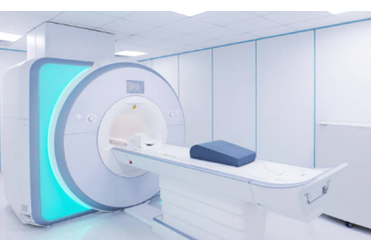 The latest Harvard study was published by JAMA Oncology. Researchers determined that using the MRI scans helped identify 289 men out of 651 men who had significant prostate cancer (Gleason 7 or higher). The MRI scan showed that 38 percent of biopsies could be avoided while identifying almost 90 percent of significant cancers.
The latest Harvard study was published by JAMA Oncology. Researchers determined that using the MRI scans helped identify 289 men out of 651 men who had significant prostate cancer (Gleason 7 or higher). The MRI scan showed that 38 percent of biopsies could be avoided while identifying almost 90 percent of significant cancers.
Having a prostate biopsy is not a pleasant experience. A large percentage of prostate biopsies are either negative, or the cancer they discover is low risk, not requiring aggressive treatment. Researchers in this study concluded that having an MRI first should help a significant number of men avoid a prostate biopsy.
The most advanced technology currently available is called 3-Tesla multi-parametric MRI.
Preventing and Surviving Prostate Cancer
Greg Feinsinger, M.D., runs the nonprofit Center for Prevention and Treatment of Disease through Nutrition. He recently wrote an article that was published in the Post Independent Citizen Telegram, titled, “Doctor’s Tip: How to Prevent and Survive Prostate Cancer.” Dr. Feinsinger points out in the article: “A 50-year-old American man has a 40 percent risk of eventually developing slow-growing non-fatal prostate cancer that will never cause symptoms or kill him; a 16 percent risk of developing prostate cancer that will cause symptoms and require some type of treatment; and a 2.9 percent risk of fatal prostate cancer.”
He further points out that many treatments are available for dealing with prostate cancer, but prevention is the best approach. And, while many men have a genetic predisposition for prostate cancer, what you eat can help influence whether or not these genes are turned on.
Plants contain micronutrients that can kill abnormal cells before they become cancerous. Foods from animals don’t have nutrients that can perform that function. Here are some of the steps Dr. Feinsinger recommends to prevent prostate cancer or to slow or reverse the progression of the disease:
- Avoid cow’s milk. Dr. Michael Greger, in his book, How Not to Die, notes that, “nutrition experts have expressed concern that the hormones in dairy products and other growth factors could stimulate the growth of hormone-sensitive tumors,” including prostate cancer.
- Avoid eggs, which contain choline that is converted into a toxin which increases the risk of prostate cancer. “Eating even a few eggs a week doubles the risk of prostate cancer progression such as bone metastases.”
- Avoid cooked meat. Carcinogens in cooked meat can promote prostate cancer.
- Avoid fatty foods. These can increase prostate cancer risk.
- Increase your intake of fruits and vegetables. These foods help kill off mutant cells according to Dr. Neal Barnard in The Cancer Survivor’s Guide. Plant-based foods also impact biochemical factors, such as hormones that stimulate prostate cancer growth.
- Be wary of taking testosterone supplements, which can stimulate prostate cancer growth.
Dr. Barnard says, “By boosting vegetables, fruits, beans and whole grains and avoiding dairy products, meats, eggs and fried foods, men are able to take advantage of protective nutrients and avoid cancer-promoting factors.”
Newly Developing Technology Found to Work on Previously Untreatable Prostate Cancer
An experimental therapy is being used with some success to destroy advanced, metastatic cancer that has been untreatable by current treatment protocols.
Prostate cancer cells produce receptors called prostate-specific membrane antigens (PSMA). Certain molecules are able to locate and bind to these receptors. Radioactive isotopes can be attached to these molecules and carried to the cancer cells.
Treatment is done in two stages. The first stage is imaging, which is done with gallium-68 or fluorine-18 which can be detected using PET scanners, producing 3-dimentional images of the body with all cancer sites identified.
After this is done, lutetium-177, which produces high doses of beta radiation is used. Lu-177 is also a PSMA seeker and it targets the cancer cells identified by the previous scan.
This experimental treatment is called LuPSMA and is being used in trials on men with untreatable metastatic cancer.
An IFLScience article on this subject states that “A paper in Lancet Oncology reports that among 30 participants for whom chemotherapy had failed, all but one showed measurable prostate specific antigen reductions when given LuPSMA, more than halving in 17 cases, and in one case disappearing entirely. Eleven of the 30 described a major reduction in disease, and most of the tumors that could be measured shrank.”
More research is needed before this technology can be applied more broadly.
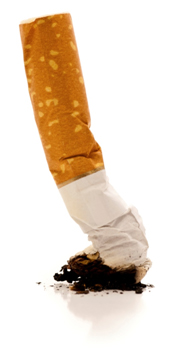 Diagnosed with Prostate Cancer? Stop Smoking. Here’s Why…
Diagnosed with Prostate Cancer? Stop Smoking. Here’s Why…
The Economic Times reported that smokers who have been diagnosed with prostate cancer have a significantly lower risk of recurrence if they stop smoking soon after diagnosis.
It has long been known that smoking is linked to numerous cancers, including prostate cancer, but this finding, based on a retrospective study, clearly shows that if men stop smoking when diagnosed with prostate cancer they can greatly increase their chances of long-term disease-free survival.
The international study was conducted in Austria, Switzerland, Spain, Jordan, Japan and the USA. It involved seven studies and 22,549 prostate cancer patients who were treated with either surgery or radiotherapy. Their main finding was that men who continued to smoke “had a significantly higher risk of recurrence, of developing new metastases and a higher risk of dying from cancer.”
So, if you are a smoker and you’re diagnosed with prostate cancer, you have one more reason to give up the butts.
Eating Your Way to Better Prostate Health
What you eat is one of the greatest risks for prostate cancer and it’s something you have direct control over. The “Men’s Eating and Living (MEAL)” study, now in its third trial, is analyzing the impact of diet on men with prostate cancer. Researchers want to know if a plant-based diet can slow down progression of the disease. The diet consists of nine servings of fruits and vegetables, two servings of whole grains and one serving of beans or legumes every day.
The nine daily servings of fruits and vegetables have specific guidelines, which include nutrients and antioxidants that have been found to be protective against prostate cancer:
- Eat two servings of tomatoes and tomato products.
- Consume two servings of cruciferous vegetables such as broccoli, cauliflower, Brussel sprouts, cabbage, kale, and turnips.
- The whole grains can include oatmeal, quinoa, barley, whole wheat bread, and brown rice.
- The single serving of beans or legumes is high in protein, low in fat, and high in fiber. These might include soybeans and soybean products like soymilk, edamame, or tofu; and dried beans and legumes like lentils, chickpeas, kidney beans or black beans.
The diet also restricts foods that may have a negative impact on prostate cancer. Consumption of these foods should be minimized:
- Red meat or processed meat like hot dogs, luncheon meats, or canned meats.
- Other sources of saturated animal fat like butter, whole milk, or eggs.
Learn more about this ongoing study.

We’ve been producing BOB Tales newsletters monthly for more than 17 years. During this time there have been important articles that many new members haven’t seen, and some long-time members may have forgotten. So, we decided to periodically re-run articles from past newsletters. The following is from August 2004.
The Top 20 Most Healthful Foods
The U.S. Department of Agriculture has developed a list of the top 20 most healthful foods. They all happen to be antioxidant-rich foods. The USDA nutritionists examined more than 100 kinds of fruits, vegetables, nuts, spices, cereals and other foods. Not surprisingly, fruits, vegetables and beans claimed nearly all the spots in the Top 20. Using David Letterman’s “Late Night” style, here’s the list:
20. Gala apples
19. Plums
18. Black beans (dried)
17. Russet potatoes (cooked)
16. Black plums
15. Sweet cherries
14. Pecans
13. Granny Smith apples
12. Red Delicious apples
11. Strawberries
10. Raspberries
9. Prunes
8. Blackberries
7. Artichokes (cooked)
6. Cranberries
5. Blueberries (cultivated)
4. Pinto beans
3. Red kidney beans
2. Blueberries (wild)
And the number one most healthful food:
1. Small red beans (dried)
Small red beans look like kidney beans—same color and shape—except they’re smaller. They’re sometimes referred to as Mexican red beans, but they are grown only in Washington, Idaho and Alberta, Canada.

Members Continue to Respond to Negative NYT Article
We continue to receive emails from members in response to the New York Times article we mentioned in last month’s BOB Tales. The theme of the article, written by Jay Hancock of Kaiser Health News, was: 1) Proton therapy hasn’t been proven to be worth the higher cost for treating common cancers such as prostate and breast cancer; 2) There is too much proton capacity; and 3) There aren’t enough patients for the number of proton centers that have been built.
We share some member messages with you below—we salute our group for continuing to spread the word.
BOB member Jerry Peterson from Atlanta, GA, sent us an email including a response he wrote to someone who inquired with him about the article. An excerpt from that message is below.
… The [NYT] article was written by a reporter for Kaiser Health and to my knowledge; Kaiser Health does not operate a proton facility … If you look at the successful proton facilities, they are reasonably large and accessible metropolitan areas and have ties with large healthcare systems or medical schools. Some locations of other facilities don’t fit that criteria and/or don’t have ties with large healthcare systems. These seem to be the facilities that are struggling.
… There remains a general bias—I pulled the following from the American Cancer Society’s website describing treatment options for prostate cancer.
Although in theory proton beam therapy might be more effective than using X-rays, so far studies have not shown if this is true. Right now, proton beam therapy is not widely available. The machines needed to make protons are very expensive, and they aren’t available in many centers in the U.S.
I think the only way this will change is for those of us who have enjoyed the benefits of proton therapy to keep spreading the gospel
Member Robert Ferre from San Antonio, TX, wrote an “open letter to Jay Hancock” on his blog. Robert sent us the following message last month:
Did you know Hancock has published a second article using the same sources, same data, and with the same negative attitude? Sheesh … It is so much easier to be a critic than a supporter. Sells better, too … Why not just acknowledge that technology is expensive at first, and then with volume and support, it gets cheaper. We all just have to work harder.
Below is an excerpt from Robert’s letter to Mr. Hancock:
Statistically, the potential market would support 10 times as many proton therapy centers. Is the problem excessive capacity? Dubious science? Greedy investors? No. The real problems are resistance by the medical establishment, denial of insurance coverage, and lack of public awareness, combined with confusion and misinformation caused by articles such as yours. Denial of proton therapy causes suffering and even death. Why would you want to be a part of that effort?
Member Ron Nelson of Irmo, SC, also wrote a lengthy rebuttal to the NYT article on his blog. An excerpt is below.
Hancock lets his readers assume that demand for proton therapy is lagging simply because patients reject it. More accurately, he should clearly explain that demand is stifled because most patients never heard of it, many doctors don’t inform them about it, and insurers often won’t cover it. The truth is that patients who overcome those obstacles often choose proton therapy.
Update on Members Treated Long Ago
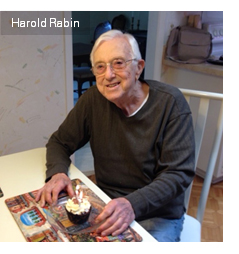 Harold Rabin
Harold Rabin
Harold Rabin was treated with proton therapy in 1991. How’s he doing 27 years later? In May he celebrated his 97th birthday. “I am getting along well,” Harold told us. “I still live alone in my house and I drive a car legally.”
Harold repeatedly tells us how thankful he is for proton therapy at Loma Linda University Cancer Center. He’s also grateful he didn’t listen to his urologist who recommended surgery. “I told him about my choice to have proton therapy and his mood abruptly changed,” Harold said. “All of a sudden I wasn’t ‘Harold’ anymore; I was ‘Mr. Rabin’ … His next comment was, ‘Mr. Rabin, if you want to be in an experimental program, that’s your business.’” Looks like the experiment worked.
Stuart Cooper
Member Stuart Cooper was treated with proton therapy at Loma Linda University Cancer Center in 2005. “I’m alive and well,” he told us. “I’m in great health and I’ve had absolutely no urological issues.” Stuart has spent “zero dollars” on healthcare since his treatment, except for well-visits.
Stuart is on our former patient reference list. He told us he recently received a call from a newly diagnosed man who was afraid to make contact with anyone on the list if they’d been treated more than 10 years ago. “I was scared you might be dead,” the man said to Stuart. On the contrary, Stuart is living his best life…
Member Feedback: How Are We Doing?
We love to hear from our members. We ask for your feedback in every issue of BOB Tales and when we ask, we mean it. Below are some recent messages we’ve received.
Congratulations on your many years of communicating the good news about proton treatment. Ten thousand members is an impressive number. God bless you, Bob and Deb, for all the work you do in this endeavor.
Vern Nelson, Osprey, FL
Treated at Loma Linda University Cancer Center in 2003
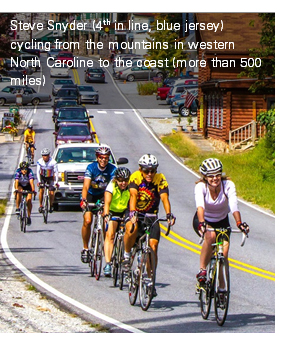 I became a member of the Brotherhood of the Balloon a few years back when I was diagnosed with prostate cancer. I would like to thank you for guiding me to the data I needed to support my battle with Blue Cross Blue Shield for proton therapy. Also, without reading stories of denials and appeals from former patients and BOB members, I may have given up; those stories gave me hope to fight on … Thank you also for the newsletter. Without it, my health would not be what it is today (Healthy as an ox—cycling 150 to 200 miles per week!).
I became a member of the Brotherhood of the Balloon a few years back when I was diagnosed with prostate cancer. I would like to thank you for guiding me to the data I needed to support my battle with Blue Cross Blue Shield for proton therapy. Also, without reading stories of denials and appeals from former patients and BOB members, I may have given up; those stories gave me hope to fight on … Thank you also for the newsletter. Without it, my health would not be what it is today (Healthy as an ox—cycling 150 to 200 miles per week!).
Steve Snyder, Roanoke Rapids, NC
Treated at MD Anderson in 2016
I really enjoy reading the newsletter! I wanted to let you know I just finished 28 treatments in San Diego. I’m happy to be part of the BOB community. Keep up the great work!
P.S. Bob’s book was spot on—I used it as a reference tool throughout my treatment.
Bob Romness, Lincoln, CA
Treated at California Protons in 2018
Deb: The tears were flowing as I read the moving tribute written by your father. It made me feel humble and lucky to be your friend, even if it is only on the Internet. Thank you so much for all you do for the members of the BOB. I’m sure your financial compensation is below what you deserve, but hopefully you are richly rewarded in more important ways!
Arlind Hackett, Highland, CA
Treated at Loma Linda University Cancer Center in 2015
Do you have feedback on our newsletter or anything else we do? Just want to let us know how you’re doing? Please write to us.

Your Generosity is Making a Difference
One component of the BOB mission is to give something back to the institution that saved our lives and preserved the quality of our lives.
Each year a growing number of BOB members give something back. Some make gifts every year, and some even give monthly. A few years ago, we learned that close to 40 percent of BOB members have made gifts to Loma Linda University Cancer Center (LLUCC) or Loma Linda University Health (LLUH), the parent organization. To date, BOB members have made gifts totaling close to $13 million.
One beneficiary of this giving is the Robert J. Marckini Endowed Chair at Loma Linda, which is funding important proton therapy research thanks to your generosity.
What is an Endowed Chair?
An endowed chair is a distinction awarded by an institution, usually to an individual, in recognition of past and potential contributions to the institution’s mission. In addition to the academic honor given to the individual, an endowed chair provides funding for specific programs, and is supported by payout from interest earned on the principle collected. So, the money raised for an endowed chair is always protected. The interest earned from the endowment is used to fund research. This interest is typically around 4 percent.
Acknowledging Gifts
Last year we asked the Department of Philanthropy at LLUH to begin sending us the names of members who are making gifts so we could contact them and acknowledge them for their generosity. Each month, Bob and Deb reach out and attempt to contact our members who have made gifts. Some are hard to track down as they are often active and traveling. But we do manage to reach most of them.\
The stories we hear from these members are heartwarming. We occasionally share them here. Most just say they are grateful for the gift they have been given and just want to show their appreciation. Hundreds give each year and the impact of your giving is making a difference by providing funding for proton therapy research and other important programs that will benefit others in the future.
We sincerely thank you for your continued generosity!
How to Give to Proton Therapy Research
- Donate Online: Visit the LLUCC website.
- Send a Check: Make it out to “LLUCC Proton” with “Marckini Chair” on the memo line and send to: LLUH, Office of Philanthropy, P.O. Box 2000, Loma Linda, CA 92354.
- Make a Call: Contact Elvia DeHaro at 909-558-501
How to Give to Vision 2020
- Donate online: Visit the LLUH website.
- Send a check: Make it out to: “LLUH Vision 2020.” Mail to: LLUH, Office of Philanthropy, P.O. Box 2000, Loma Linda, CA 92354.
- Make a call: Call 909-651-2020.
How to Make a Future Gift
- Make a future gift: Contact Todd Mekelburg at the Office of Planned Giving at Loma Linda University Health at 909-558-5376 or [email protected].
- Other ways to give: Contact Matt Miller at the Office of Philanthropy at Loma Linda University Health at 909-558-3582 or [email protected].

Recap: BOB Reunion/Loma Linda “Comes to You,” Portland, OR
Loma Linda University Health recently hosted a proton patient reunion and Loma Linda Comes to You event at the Portland Adventist Medical Center. There were about 60 attendees including BOB members, current and former proton patients, and LLUH staff members. Andrew Millard, Manager, Radiation Medicine Administration at LLUCC gave a presentation to the crowd including an update on happenings in the proton world and a told a few personal patient stories. If you know Andrew, you won’t be surprised to know that he made lots of jokes and got a lot of laughs. He told us a good time was had by all.
NAPT Conference 2019
Join the National Association for Proton Therapy for the 2019 National Proton Conference March 24 - 27, 2019, at The Biltmore Miami-Coral Gables in Coral Gables, FL. Attendees will include physicians, nurses, therapists, patients, proton therapy directors and managers. Learn more.

Surprising Health Risk for Men
According to Bottom Line Personal magazine, social isolation increases the risk for heart disease, certain cancers, and dementia while decreasing immune system function. Associate professor of psychiatry at Harvard Medical School, Dr. Richard Schwartz, MD, says, “Social isolation has as important an effect on our health as smoking, high blood pressure, or obesity.”
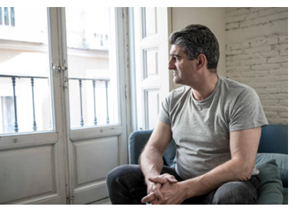 Even after bad lifestyle habits are taken into consideration, time actually spent alone boosted the risk of dying by about 30 percent in people who suffered a stroke or heart attack, according to a study of nearly 480,000 men and women and published in Heart, a medical journal.
Even after bad lifestyle habits are taken into consideration, time actually spent alone boosted the risk of dying by about 30 percent in people who suffered a stroke or heart attack, according to a study of nearly 480,000 men and women and published in Heart, a medical journal.
After retirement and with the kids grown up and gone, men often have few social connections besides their spouses. Women have similar issues, according to Dr. Schwartz, but they seem to be more inclined to form new friendships in their senior years.
Dr. Schwartz suggests that men avoid the isolation trap by setting up regularly scheduled get-togethers centered around shared activities, such as playing golf every weekend.
Health Phrases to Live By
Dr. Roy Buchinsky is director of wellness at University Hospital’s Cleveland Medical Center. He’s come up with several catchy slogans to help people remember healthful habits. Here are some tips to prolong your lifespan:
- If the food is white, it’s probably not right. Avoid processed carbohydrates including white bread, bagels, rice, pasta, and pizza. Replace these with whole grain products such as brown rice or pasta made from quinoa or brown rice.
- Don’t drink your fruit when you can eat your fruit. You lose much of the fiber and increase the concentrated sugar load on your body when you liquefy fruit. Fruit in its natural form is the most healthful.
- Sitting is the new smoking. Aim for 10,000 steps a day. Keep moving.
- Don’t skimp on sleep. Sleep deprivation can cause many health problems. Aim for seven to eight hours of sleep per night.
- Maintain a gratitude attitude every day. Maintaining a positive attitude can help you deal better with daily hassles.
- Don’t sweat the small stuff. Focus on the big ticket items such as health, family, work, and faith.
- Prevention is the best intervention. Vaccinations are not foolproof, but they are effective in preventing many illnesses, such as influenza, pneumonia, HPV, hepatitis, shingles, and diphtheria.
- Control the controllable. Focus on things that are within your control. Don’t waste time and energy on things that are out of your control.
- Take your work seriously, but don’t take yourself too seriously. Charlie Chaplin said, “A day without laughter is a day wasted.”
Incredible Benefits to Sleeping On Left Side
 Surprisingly, there is a considerable amount of published data on this subject and there seems to be general agreement by medical professionals that sleeping on your left side is preferred. Here are some of the reasons why, according to LittleThings and health expert, Dr. John Douillard:
Surprisingly, there is a considerable amount of published data on this subject and there seems to be general agreement by medical professionals that sleeping on your left side is preferred. Here are some of the reasons why, according to LittleThings and health expert, Dr. John Douillard:
- Relieves Heartburn: This can be especially important if your evening meal was rich and spicy.
- Helps Stop Snoring: This according to Medical Daily.
- Improves Digestion: Left side sleeping allows gravity to encourage the food waste to move more easily from the small intestine into the large intestine.
- Promotes Heart Health: Dr. Douillard says, “It makes sense that if you sleep on your left side, the lymph drainage toward the heart will again be helped by gravity, taking some of the workload off the heart as you sleep.”
- Improves Spleen Health: Drainage back to the spleen is made easier by gravity when you sleep on your left side.
- Helps Lymphatic System: According to Healthy Life Tricks, “The left side of the body is the dominant lymphatic side, and while you’re sleeping on this side, your body will have more time to filter toxins, lymph fluid and waste.”
- Helps Circulatory System: The Vein Clinic states, “If you have varicose veins, it’s a good idea to sleep on your left side – this improves circulation by reducing pressure on your vena cava (the body’s largest vein), located on the right side of the body.”
- When Pregnant, Improves Blood Flow to the Fetus: WebMD states, “Sleeping on the left side is recommended during pregnancy to improve circulation to the heart – good for mom and baby.”
Series: “Make Vegetables Taste Good”
This is the 21st segment on a subject that’s consistent with our Anticancer series. We made it our mission to find recipes that make vegetables and other healthful foods taste delicious. And, we’ve tried them all!
The following recipe was dropped on Deb Hickey’s doorstep. She and her husband Mark just started ordering HelloFresh meal kits to make grocery shopping and meal planning easier. Last week, one particular dish was superb, so they saved the recipe to make it again in the future.
HelloFresh delivers fresh ingredients and healthful, chef-curated recipes based on seasonal farm fresh ingredients. Deb chose meals from the vegetarian selection. If you’re not familiar with meal kit delivery services, learn about some of the options on Forbes.
Chickpea-Powered Mediterranean Couscous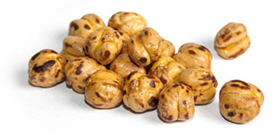
Ingredients (feeds two people):
- 1 zucchini
- 4 oz heirloom grape tomatoes
- ¼ oz thyme
- 2 scallions
- 2 cloves garlic
- 1 lemon
- 6.7 oz chickpeas
- 1 tsp smoked paprika
- ¾ cup Israeli couscous
- 1 unit veggie stock concentrate
- ½ cup feta cheese
- 1 Tbs butter
- 1 Tbs olive oil
- Salt and pepper
Directions:
Wash and dry all produce. Adjust racks to middle and upper position and preheat oven to 425°F. Trim zucchini; then cut into ½-inch cubes. Halve tomatoes. Strip thyme leaves from stems. Trim; then thinly slice scallions, keeping greens and whites separate. Mince garlic. Halve lemon.
Toss zucchini, tomatoes, and half of the thyme leaves on a baking sheet with a drizzle of olive oil. Season with salt and pepper. Roast in oven on middle rack until tender, about 20 minutes, tossing halfway through.
Meanwhile, drain and rinse half the chickpeas. On another baking sheet, toss chickpeas, paprika, a drizzle of olive oil, and a pinch of salt and pepper. Roast in oven on upper rack until crisp, about 20 minutes, tossing halfway.
Heat 1 tablespoon butter, garlic, and scallion whites in a medium pot over medium-high heat. Once butter is melted and garlic is fragrant, add couscous and remaining thyme leaves. Toss to coat. Season with salt and pepper. Cook, tossing, until couscous is lightly toasted, 2-3 minutes.
Stir stock concentrate and 1 ½ cups water into pot. Bring to a boil, then lower heat and reduce to a simmer. Cook until couscous is al dente, 10-12 minutes.
Add half the veggies, half the feta cheese, and squeeze of lemon to pot with couscous and toss to combine. Season with salt and pepper. Divide couscous mixture between plates; then top with chickpeas and remaining veggies. Sprinkle with scallion greens and remaining feta cheese.

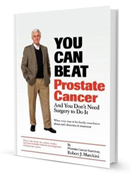 Amazon Becomes Second-Most Valuable U.S. Company
Amazon Becomes Second-Most Valuable U.S. Company
Thank you to our recent Amazon book reviewers—Katherine and Jan! We appreciate every reader who takes the time to write a review of Bob Marckini’s book.
Every single review contributes to the visibility of the book on Amazon, now the second-largest U.S. company, closely following Apple in the race to a $1 trillion market capitalization.
This accessibility of Bob’s book on Amazon is critically important now more than ever. Amazon has 310 million active customers and 90 million U.S.-based Prime subscribers. Of those Amazon users, 90 percent won’t buy an item with fewer than three stars. The number of reviews also matter—they serve as digital focus groups—the more positive reviews, the more likely a user will purchase a product.
We’re slipping!
Following Amazon’s rise to No. 2, they redesigned their algorithm and search results interface. When a user queries “prostate cancer,” results appear in blocks, rather than a list, and Bob’s book is now in the fifth position, down from No. 3 where it has remained for years. The first result is a paid advertisement, but we’re not sure how the other three books (all but Dr. Patrick Walsh’s book) achieved their prominent visibility considering the total number of reviews on those books doesn’t equal a third of Bob’s book reviews.
Take a minute!
Top placement of Bob’s book on Amazon is critical to newly diagnosed men finding their way to proton therapy. So many urologists and family providers aren’t informed about proton therapy and most mainstream media discount proton therapy as a viable treatment option. We’re fighting daily for this to change! One way is through the book that helped so many of you learn about proton therapy for prostate cancer. Please help others find it!
Please post a review of Bob’s book on Amazon and rate it from one to five stars. Click on the gray “Write a Review” button. It only takes a minute …
Excerpts from recent reviews are below:

We feel lucky that this treatment is available and better understand the process after reading this book.
You must read this book! … It reinforced our thoughts regarding proton therapy. We feel lucky that this treatment is available and better understand the process after reading this book. Thank you, Mr Marckini. —Jan

Great Book
Great book full of helpful information … I highly recommended it for anyone looking at treatment options for prostate cancer. —Katherine
Buy Online, in Bulk or in Spanish
Online: Paperback: $19.00--•--Kindle: $7.99--•--NOOK Book: $9.99--•--Apple iBook: $9.99
In Bulk: Conctact us for a discount price list. Proceeds from book sales support proton therapy research through the Robert J. Marckini Endowed Chair at LLUCC.
In Spanish: Buy the print version or in eBook format.
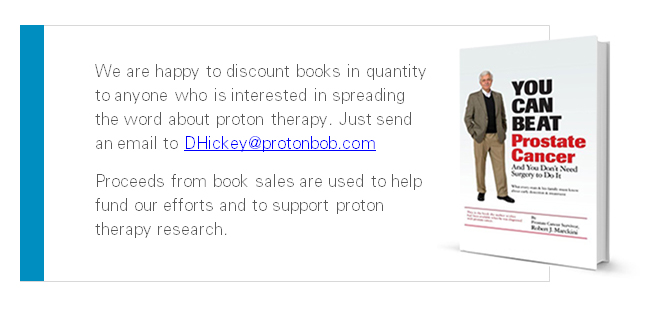

Estate Planning Hints
BOB Member Ron Hendricks is Director of Gift Planning for Trinity Western University. He regularly copies us on his “News from Ron” mailings, which are helpful hints on estate planning to the readers of his newsletters. We have found Ron’s suggestions to be timely and beneficial. With his permission we periodically share some of his wisdom with our membership. This segment is called …
Tax Free Sale
Many individuals and families find themselves reaping the rewards of astute investment decisions made years ago. Sometimes it is easier to get into investments than getting out of them because of the shrinkage caused by the capital gains tax—a tax on the growth of the original investment—can drastically reduce the attractiveness of selling this investment.
The tax-free sale is tailored for business and property owners who find themselves in this situation. It is a plan built around the use of a special trust that has four significant benefits:
- Bypass Capital Gains Tax
- Income for Life
- Charitable Income Tax Deduction
- Transfer business or property to family
This special trust makes it possible for you to transfer business or property to family, sell the property tax-free, receive some much-needed cash for your retirement and benefit from an increased income stream for the rest of your life. This can be a great way to transfer your business or rental property to family during your lifetime.
First, you transfer a portion of the asset or property into a Remainder Trust for which you receive a charitable income tax deduction for the portion of the value transferred to the Trust.
You also retain ownership of the portion of the property not transferred to the trust. When the property is sold, the Trust bypasses the capital gains tax due on the portion of the land it owns. While you pay tax on the property that you retain, this gain is offset by the charitable income tax deduction you receive upon funding the Trust.
As a result, you receive cash from the full proceeds from the sale of your portion of the property, tax-free. The Trust will make annual payments equal to 5+% of the value of the trust for life.
Did You Know?
According to Thought Catalog …
- Most toilets flush in E flat.
- “Almost” is the longest word in English with all the letters in alphabetical order.
- It is impossible to sneeze with your eyes open.
- Ketchup was sold in the 1830s as medicine.
- No piece of square paper can be folded in half more than seven times.
- Nicholas Cage bought a pet octopus once because he sincerely thought it might help with his acting.
- Steve Jobs relieved stress by soaking his feet in Apple’s company toilets.
- A duck’s quack doesn’t echo, and nobody can figure out why.
- The Romans used to clean and whiten their teeth with urine.
- 315 entries in Webster’s Dictionary were misspelled.

Last Month’s Brain Teaser
A chauffeur always arrives at the train station at 5 p.m. sharp to pick up his boss and drive him home. One day, the boss arrives an hour early. He starts walking home and is eventually picked up. He’s home 20 minutes earlier than usual. How long did the boss walk before he was picked up by the chauffeur?
Hint: Look at it from the chauffeur’s perspective. And note: all the information you need has been provided.
Answer: As the chauffer’s round trip was 20 minutes shorter, he picked up his boss 10 min. before 5:00. So, the boss walked 50 minutes (4:00 to 4:50 pm).
Don’t get it? Let’s say the chauffer’s drive was normally 30 minutes each way, or 60 minutes round trip. If they got back 20 minutes earlier than usual, it means the chauffer’s round trip was 20 minutes shorter than usual. That also means the chauffer’s drive each way was 10 minutes shorter. So, the chauffer picked up his boss 10 minutes earlier than usual, which would be 4:50 pm. And that means the boss walked for 50 minutes.
Winner: This may be the first time in BOB Tales history that nobody answered the brain teaser correctly. We give you an easy one this month …
New Brain Teaser (An easy one!)
Two U.S. coins are worth 30 cents and one is not a quarter. What are the two coins?
Send your answer to [email protected] for a chance to win a signed copy of Bob Marckini’s book, You Can Beat Prostate Cancer.
Convenience Store Sign
A sign in front of a convenience store in Seattle, WA was used to promote business. One day, the owners decided to have some fun with the sign. Turns out it was better for business and now they update it daily. Following are a few examples:
- Ban pre-shredded cheese. Make America grate again.
- If you think education is costly, try ignorance.
- I checked into the hokey pokey clinic and I turned myself around.
- What happens if you get scared half to death twice?
- This is my step ladder. I never knew my real ladder.
- I want to grow my own food, but I can’t find bacon seeds.
- I went to the air and space museum, but there was nothing there.
- My wife said I never listen to her … or something like that.
- Is there ever a day that mattresses are not on sale?
- The first five days after the weekend are the hardest.
The Bagpiper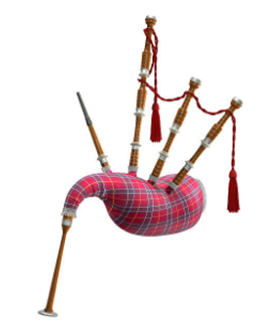
As a bagpiper, I play many gigs. Recently I was asked by a funeral director to play at a graveside service for a homeless man. He had no family or friends, so the service was to be at a pauper’s cemetery in the Kentucky back country.
As I was not familiar with the backwoods, I got lost and being a typical man, I didn’t stop for directions. I finally arrived an hour late and saw the funeral guy had evidently gone and the hearse was nowhere in sight. There were only the diggers and crew left and they were eating lunch. I felt badly and apologized to the men for being late.
I went to the side of the grave, looked down, and saw the vault lid was already in place. I didn’t know what else to do, so I started to play. The workers put down their lunches and began to gather around. I played out my heart and soul for this man with no family and friends. I played like I’d never played before for this poor, homeless man. And as I played “Amazing Grace,” the workers began to weep. They wept; I wept; we all wept together.
When I finished, I packed up my bagpipes and started for my car. Though my head hung low, my heart was full.
As I opened the door to my car, I heard one of the workers say, “I ain’t never seen nothin’ like that before and I’ve been putting in septic tanks for twenty years.”
Apparently I’m still lost.
Forget Newton and Galileo—Here Are the Real Laws of Nature
Law of Mechanical Repair: After your hands become coated with grease, your nose will begin to itch and you’ll have to go to the bathroom.
Law of Gravity: Any tool, nut, bolt, screw, when dropped, will roll to the least accessible corner.
Law of Probability: The probability of being watched is directly proportional to the stupidity of your act.
Variation Law: If you change lines (or traffic lanes), the one you were in will always move faster than the one you are in now.
The Coffee Law: As soon as you sit down to a cup of hot coffee, your wife will ask you to do something that will last until the coffee is cold.
Law of Physical Surfaces: The chances of an open-faced jam sandwich landing face down on a floor, are directly correlated to the newness and cost of the carpet.
Brown’s Law of Physical Appearance: If the clothes fit, they’re ugly.
Wilson’s Law of Commercial Marketing Strategy: As soon as you find a product that you really like, they will stop making it.
Doctors’ Law: If you don’t feel well, make an appointment to go to the doctor. By the time you get there you’ll feel better. But don’t make an appointment and you’ll stay sick. This has been proven over and over with taking children to the pediatrician.
Quote of the Month:
“Some people are born on third base and go through life thinking they hit a triple.” —Barry Switzer

The Kids Who Stole a Bachelor’s Heart
Pittsburgh Police Detective Jack Mook was a self-proclaimed bachelor who loved the single life, doing what he wanted while he was off-duty. He often went to the gym, where he boxed and volunteered his time to teach kids boxing. He became particularly close to two brothers, who came in almost every week for several years to learn from Mook.
One day, the brothers stopped showing up, and Mook knew something was wrong. After a search, Mook found the older brother, Josh, at his school. “I got him in the car and he didn’t look good. He just started crying …” Mook said.
The boy told Mook the horrible conditions the brothers were living in and that they wanted to get out. He said they didn’t have a bed and had slept on a couch or floor for six years. Their house was so dilapidated, infested with roaches and rats, it was eventually condemned.
Through an emergency appeal, Mook decided to foster the boys, and later went on to adopt them, finalizing the most important chapter in his life in 2014.
Mook says the boys have changed his life. The self-proclaimed bachelor is not only their dad; he’s also happily married and has three step-children. Because his big-hearted story went viral, women were lining up to meet—and marry—this ordinary superhero.
Low PSAs to all!
Bob Marckini and Deb Hickey
To print the BOB Tales newsletter or view the newsletter with a larger font size, click here for the PDF file.
NO MEDICAL ADVICE: Material appearing here represents opinions offered by non-medically-trained laypersons. Comments shown here should NEVER be interpreted as specific medical advice and must be used only as background information when consulting with a qualified medical professional.
